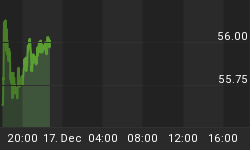With negative sentiment toward China reaching an extreme in recent months, patient investors have been rewarded with recent news of improving data from the Asian giant.
CLSA Sinology's Andy Rothman reported that in September, retail sales growth rose 13.2 percent, which was the fastest pace of the year. Real urban disposable income grew nearly 10 percent and real rural disposable income rose more than 12 percent during the first three quarters of the year. And, while export numbers are weak, China has "so far avoided the large-scale export-sector layoffs that led to 2009's massive stimulus," says Andy.
There was strength in commodity imports, too. Copper imports into China increased 11 percent compared to the previous month due to increased demand from power infrastructure, white goods restocking and auto production. Iron ore rose a modest 4 percent compared to the previous month, which is encouraging. There was also a sharp rebound in oil imports most likely due to holiday restocking and lower international prices. In fact, Pareto Securities found that Chinese implied oil demand came in at an all-time high of 9.8 million barrels per day in September.

The markets also saw an increase in fixed asset investment (FAI), a measure of capital spending, which grew at "the fastest pace since October 2011," says CLSA. According to Credit Suisse, "a surge in transportation spending in the month of September [is] starting to reflect the project approvals for highway, rail, airport, and metropolitan transport projects announced in May and June."
While Credit Suisse says FAI growth was boosted by government investment stimulus, CLSA also notes that fixed asset investment and capital spending by private firms has been rising faster than state-owned firms for 30 of the last 31 months.
Money supply, a key lubricant of the economy and markets, also continued to increase, and this has historically driven Chinese equities. Take a look at the chart below, which shows the year-over-year money supply compared to the MSCI China Index over the past decade. Over the past 10 years, after the supply in money bottomed, stocks soon rebounded.
On January 31, 2012, money supply hit a near decade low of 12.4 percent year-over-year growth. Since then, the number has been creeping higher, rising sharply to 14.8 percent in September, and shortly thereafter, equities responded.

The Wall Street Journal recognized the improvement in Asian stocks and investor sentiment recently, suggesting that the "region's economy could be nearing the end of a slowdown." I've been trying to temper investors' expectations of China as weak economic data caused investors to be skittish, telling Investor Alert readers that it wasn't the time to be bearish. Now, "if the Chinese economy shows sustained signs of stabilizing, it would remove a major overhang of worry for investors in Asia, and may spur more capital raising and other deals as investors become confident enough to switch money out of bonds and back into equity markets," says The Journal.
This appears to be a good time to be investing in China, as stocks are historically cheap. At the beginning of October, BCA noted that there was a "prevailing pessimism" around China and that the stocks were "currently trading at hefty discounts to world averages and even to euro zone stocks." The firm indicated that Chinese shares had a forward price-to-earnings ratio of below 9 times; the world and U.S. benchmarks traded at 12 and 13 times, respectively.
Chinese stocks are also cheap compared to emerging markets. In 2007, China traded at a 75 percent premium to emerging markets. Today, Chinese stocks trade at a 20 percent discount. If you look at a comparison of price-to-earnings in China to those in emerging markets, you have to go back to 2006 to find that ratio as low as it is today.

The low price-to-earnings indicates to me that the negativity pendulum has swung too far. "Investors have turned from euphoria at the height of the 'China mania' five years ago to extreme pessimism," says BCA.
Back in April, I listed three trends that global investors should watch in China: A rebound in the liquidity cycle signaling a rally in equity prices, a new leadership with an incentive to maintain growth, and Chinese stocks reverting to their mean, as history appears to favor Chinese stocks landing in the top half of emerging markets. Time will tell.
















